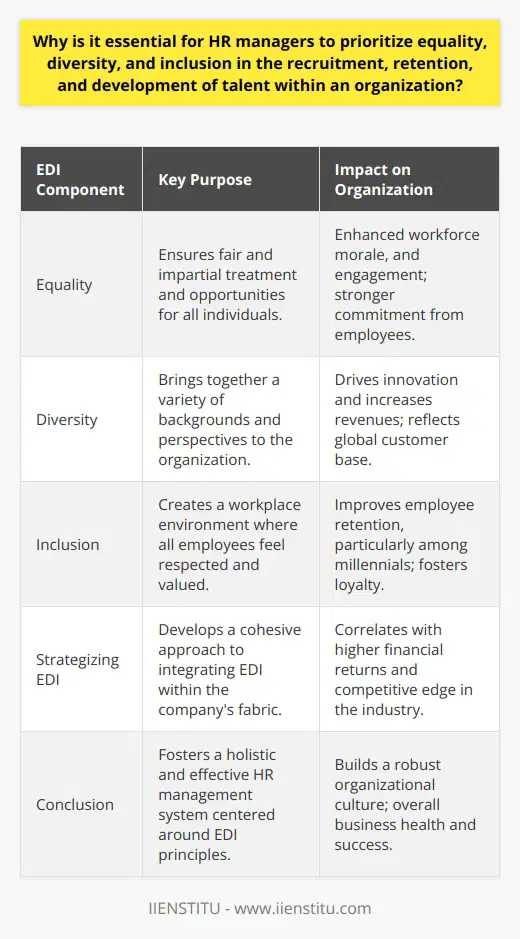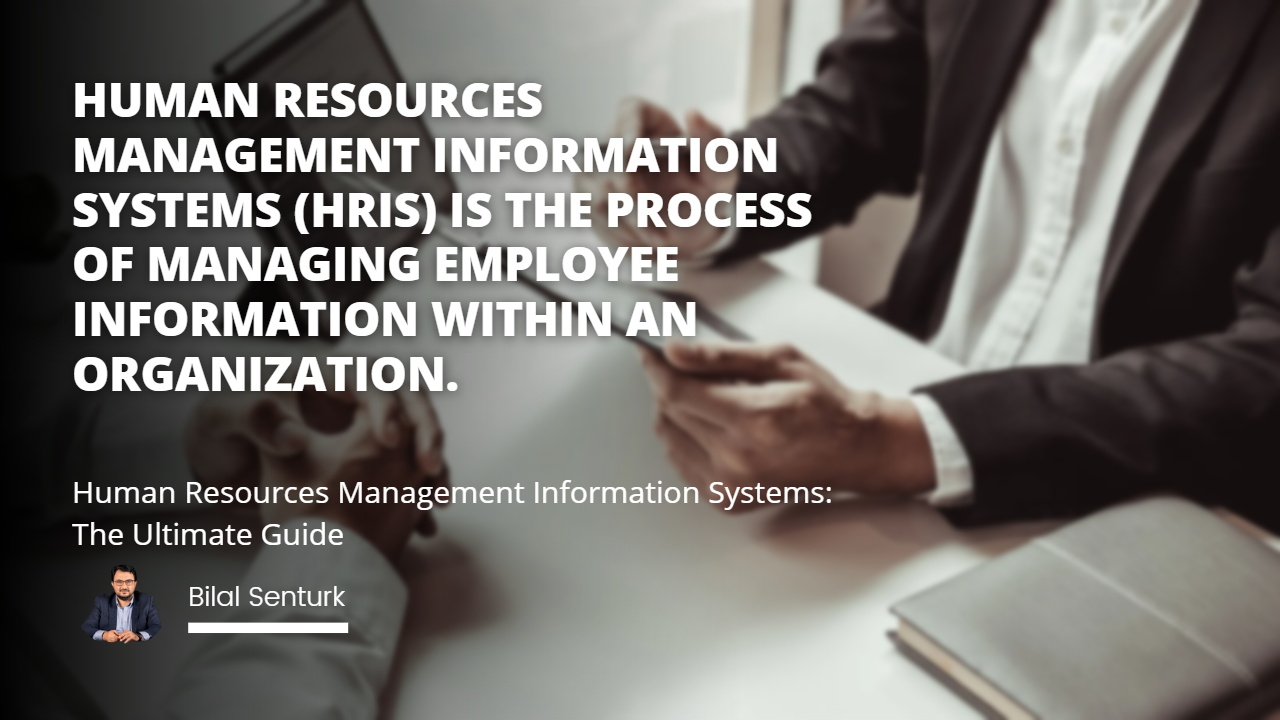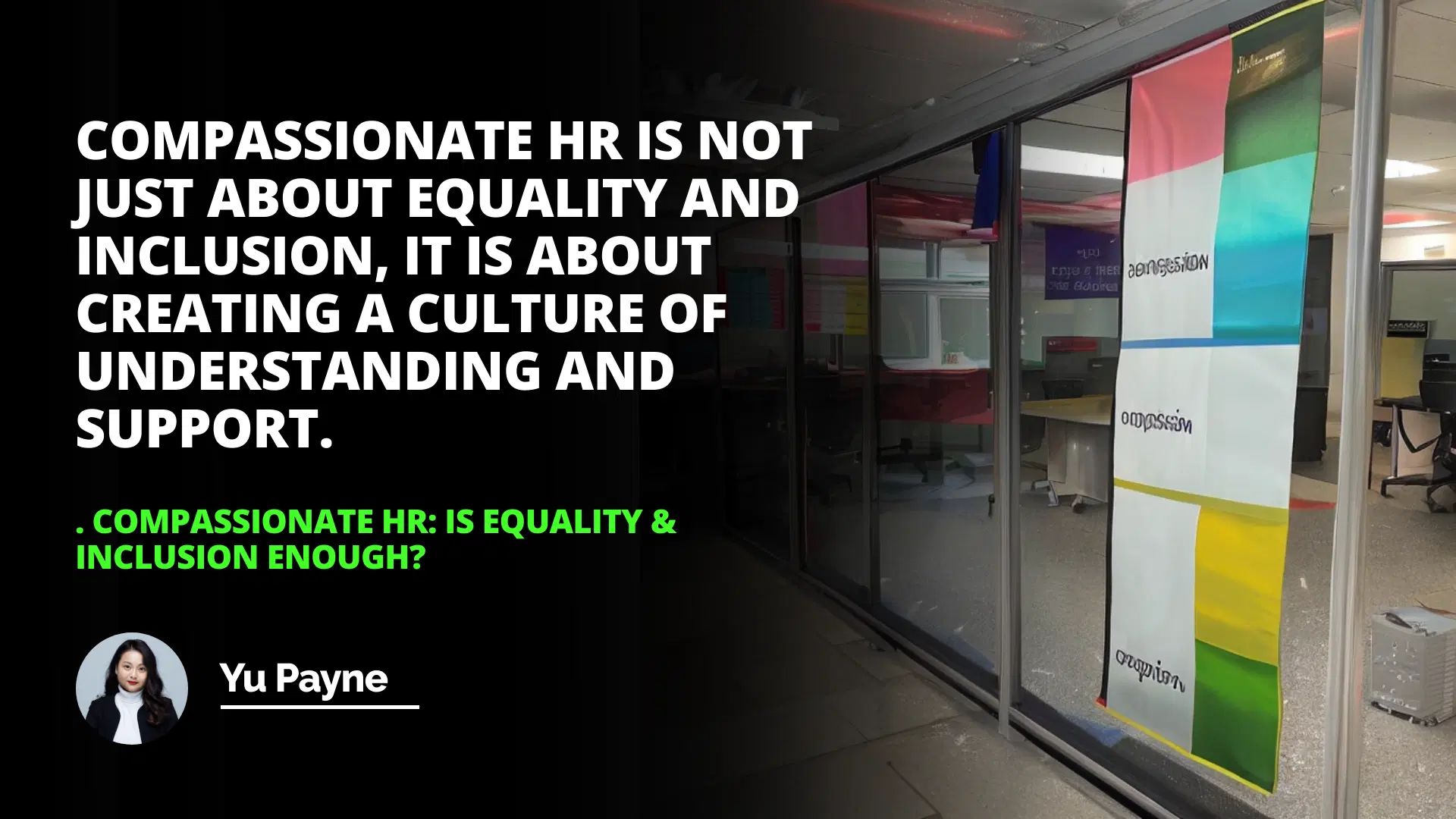
Cultivating Compassion: The Heart of Successful Business
When I first stepped into the world of business, I was brimming with enthusiasm and hope. I believed that companies were not just profit-making machines but could be forces for good, places where people came together to achieve common goals while uplifting each other. Over the years, I've come to realize that the heart of any successful organization lies in its ability to cultivate a compassionate and inclusive culture. It's not just about the bottom line; it's about people, relationships, and the impact we have on each other's lives.
Introduction
Definition of Compassionate Business
Equality and Inclusion as Foundational Principles
Corporate Leaders' Responsibility to be Compassionate and Just
Facebook's Diversity in Senior Workforce
Conclusion
Understanding Compassionate Business Practices
At its core, compassionate business practices are about creating an environment where every individual feels valued, respected, and empowered. It's about fostering a company culture that prioritizes the importance of equality and inclusion in the workplace as foundational principles. This means going beyond mere compliance with legal standards--it's about embedding kindness, empathy, and fairness into the very fabric of the organization.
I remember a time when a colleague faced personal challenges that affected her work performance. Instead of reprimanding her, our human resource team stepped in to offer support. They provided flexible working hours and connected her with our employee resource groups focused on mental health. This compassionate approach not only helped her recover but also reinforced her loyalty to the company. Human resources (HR) professionals play a pivotal role in shaping such empathetic workplaces.
The Pillars of Equality and Inclusion
Equality and inclusion aren't just buzzwords; they're essential for building a thriving organizational culture. When employees feel that they have equal opportunities to succeed and that their unique perspectives are valued, they're more likely to contribute meaningfully. Diversity and inclusion strategies for businesses help break down barriers and dismantle systemic biases that can hinder progress.
An effective HR management strategy should include:
1- Inclusive Recruitment Practices: Ensuring job postings attract a diverse pool of candidates.
2- Bias Training: Educating staff to recognize and overcome unconscious biases.
3- Equitable Promotion Paths: Providing equal opportunities for advancement.
4- Cultural Competence Development: Encouraging understanding and respect for different cultures.
5- Employee Feedback Mechanisms: Creating safe channels for employees to voice concerns.
By implementing these steps, companies can build an environment where adaptability in human resources management strategy becomes a strength, allowing them to respond effectively to changing workforce dynamics.
The Responsibility of Corporate Leaders
Corporate leaders and their responsibility for compassion cannot be overstated. Leadership sets the tone for any organization. When leaders prioritize empathy and fairness, it trickles down through every level of the organization.
Once, during a company-wide meeting, our CEO shared personal anecdotes about overcoming challenges and emphasized the importance of supporting one another. This openness fostered a sense of unity and reinforced our firm culture of mutual respect.
Leaders can promote compassion by:
Modeling Empathy: Demonstrating genuine care for employee well-being.
Promoting Work-Life Balance: Recognizing the importance of life outside work.
Encouraging Open Communication: Fostering an environment where employees feel heard.
Recognizing Contributions: Celebrating both big wins and small efforts.
A Cautionary Tale: Facebook's Diversity Challenges
Not all companies have successfully embraced these principles. Facebook's diversity in its senior workforce has been a subject of scrutiny. Reports indicated that only 34% of their senior leadership positions were held by women, and a staggering 78% were white males (Thomas & Ely, 1996). Such statistics highlight a significant lack of diversity and raise concerns about inclusivity within the organization's upper echelons.
This imbalance can lead to:
Groupthink: A lack of diverse perspectives hindering innovation.
Employee Disengagement: Minority groups feeling undervalued or excluded.
Public Relations Issues: Negative perceptions affecting the company's image.
It's essential for companies like Facebook to adapt their human resource management strategies to address these disparities. By doing so, they not only improve their organizational culture but also enhance their competitiveness in the global market.
Embracing Compassion: The Path Forward
Creating a compassionate business isn't a one-time effort; it's an ongoing journey. Here are some steps companies can take to cultivate a compassionate company culture:
1- Establish Clear Values and Mission: Define what compassion means for your organization. Incorporate these values into your mission statements and everyday practices. This clarity helps align all employees towards common goals.
2- Provide Training and Development: Invest in training programs for diversity and inclusion in the workplace. Educate employees about the importance of empathy, active listening, and cultural competence.
3- Foster a Supportive Environment: Encourage collaboration over competition. Create spaces where employees can share ideas without fear of judgment. Employee resource groups can be instrumental in providing support networks within the company.
4- Implement Fair Policies: Review company policies to ensure they promote fairness and equality. This includes equitable pay, unbiased performance reviews, and transparent promotion criteria.
5- Engage in Community Outreach: Extend compassion beyond the company by engaging in community service and social responsibility initiatives. This not only benefits society but also enriches the company's organizational culture.
Compassionate HR is not just about equality and inclusion but about creating a culture of understanding and support.
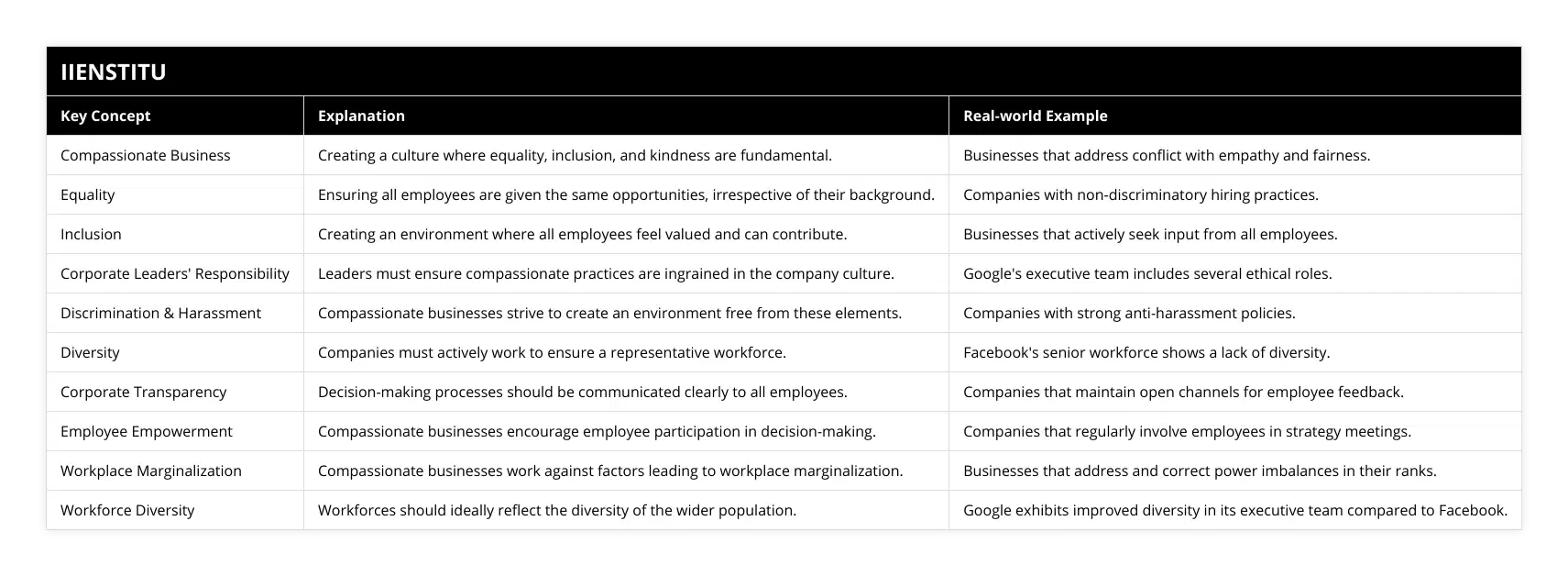
Compassionate HR is not just about equality and inclusion but about creating a culture of understanding and support.
The Benefits of Compassionate Leadership in Organizations
Embracing the benefits of compassionate leadership in organizations isn't just the right thing to do--it's also good for business. Here are some of the benefits:
Increased Employee Engagement: Employees who feel valued are more motivated and productive.
Better Talent Retention: Compassionate workplaces attract and retain top talent.
Enhanced Reputation: Companies known for their compassionate practices enjoy better public perception.
Innovation and Creativity: Diverse and inclusive teams bring a wealth of ideas and perspectives.
In a world that's constantly changing, adaptability in human resources strategies becomes essential. By prioritizing compassion, companies can navigate the complexities of the modern business landscape more effectively.
Real-World Examples of Companies with Compassionate Cultures
Patagonia: Leading with Purpose
Patagonia, the outdoor clothing company, is renowned for its commitment to environmental and social responsibility. The company's leadership emphasizes compassionate practices by:
Offering on-site childcare and flexible schedules.
Encouraging employee activism for environmental causes.
Donating a portion of profits to environmental organizations.
This dedication has not only fostered a strong company culture but has also resonated with customers who share similar values.
Microsoft: Embracing Diversity and Inclusion
Under CEO Satya Nadella's leadership, Microsoft has made significant strides in promoting diversity, equity, and inclusion. Initiatives include:
Implementing inclusive hiring practices.
Offering programs to support employees with disabilities.
Providing unconscious bias training for all staff.
These efforts have revitalized Microsoft's image and performance, proving that compassionate leadership drives success.
Overcoming Challenges
Implementing compassionate business practices isn't without its hurdles. Resistance to change, ingrained biases, and fear of the unknown can all pose challenges of implementing compassionate HR strategies. However, with persistent effort and commitment from leadership, these obstacles can be overcome.
Some strategies include:
Open Dialogue: Encouraging conversations around challenges and fears.
Incremental Changes: Gradually implementing new practices to allow for adjustment.
Celebrating Small Wins: Recognizing progress to keep momentum.
Conclusion
Creating a compassionate business isn't just an HR initiative; it's a transformative approach that reshapes the entire organization. By prioritizing human and resources, companies create environments where employees thrive, innovation flourishes, and long-term success is achieved.
As we move forward, it's crucial for corporate leaders to take responsibility for cultivating such cultures. By embracing compassion, equality, and inclusion, businesses not only enhance their own performance but also contribute positively to society.
In the wise words of management expert Peter Drucker, "Culture eats strategy for breakfast" (Drucker, 2008, p. 123). Regardless of how robust a company's strategy may be, without a compassionate and inclusive organizational culture, success will remain elusive. Let's commit to building businesses that not only excel in profits but also in making the world a better place.
Remember, compassionate HR isn't just about policies--it's about fostering employee engagement through empathy. Let's roll up our sleeves and make it happen!
References
Covey, S. R. (2004). The 7 Habits of Highly Effective People. New York: Free Press.
Drucker, P. F. (2008). Management. New York: HarperCollins.
Edmondson, A. C. (2018). The Fearless Organization: Creating Psychological Safety in the Workplace for Learning, Innovation, and Growth. Hoboken, NJ: Wiley.
Senge, P. M. (2006). The Fifth Discipline: The Art & Practice of The Learning Organization. New York: Doubleday.
Thomas, D. A., & Ely, R. J. (1996). Making Differences Matter: A New Paradigm for Managing Diversity. Harvard Business Review, 74(5), 79-90.
Frequently Asked Questions
What are the benefits of compassionate HR practices for businesses?
Compassionate HR practices have become increasingly popular in recent years due to the positive impact they can have on businesses. From improved employee engagement and retention to better customer service and relations, compassionate HR practices can benefit businesses in many ways.
One of the primary benefits of compassionate HR practices is higher employee engagement. When employees feel that their employer cares about their well-being and is willing to invest in their growth and development, they are more likely to be motivated, productive, and loyal to their employer. Compassionate HR practices such as flexible work arrangements, adequate mental health resources and support, and meaningful recognition of employee achievements can all contribute to higher levels of employee engagement.
Compassionate HR practices can also lead to better employee retention. Employees who feel valued and supported are less likely to look for other job opportunities. This can save businesses time, money, and resources that would otherwise be spent on recruitment and training. Additionally, retaining experienced and successful employees can help companies to maintain a competitive edge in the market.
Compassionate HR practices can also help businesses build better customer relationships. When employees feel appreciated and respected, they are more likely to provide better customer service. This can result in higher customer satisfaction and loyalty, translating into more revenue for the business.
In conclusion, compassionate HR practices can positively impact businesses, from increased employee engagement and retention to better customer relations. Companies should strive to create an environment where employees feel valued and supported, which can have several positive outcomes for the business.

How can corporate leaders create a more compassionate and just workplace?
As the business world evolves, corporate leaders must embrace creating a more compassionate and just workplace. To do this, they must put in the effort to understand their employees' needs and concerns and how they can be addressed. In this article, we will discuss the various ways in which corporate leaders can create a more compassionate and just workplace.
Firstly, corporate leaders need to recognize that diversity in the workplace can bring myriad benefits to their organization. By providing a diverse and inclusive working environment, corporate leaders can create a workplace where everyone feels valued and respected, regardless of their background or identity. This will foster a culture of understanding and acceptance where everyone can participate and develop their skills.
Additionally, corporate leaders should ensure that their policies and procedures are fair and equitable for everyone. This includes having clear and consistent guidelines that protect employees from discrimination and provide equal pay for equal work. Leaders should also ensure that there are no unethical working conditions, such as long hours or inadequate compensation.
Finally, corporate leaders can create a more compassionate and just workplace by providing employees with the resources and support they need to succeed. This could include providing access to training and development opportunities, offering flexible working hours, and providing employees with the necessary tools and equipment to perform their jobs.
In conclusion, corporate leaders must recognize that creating a more compassionate and just workplace benefits their organization and the employees who work there. By understanding the needs and concerns of their employees and putting in the effort to create a diverse, equitable, and supportive working environment, corporate leaders can create a rewarding and successful workplace for everyone involved.
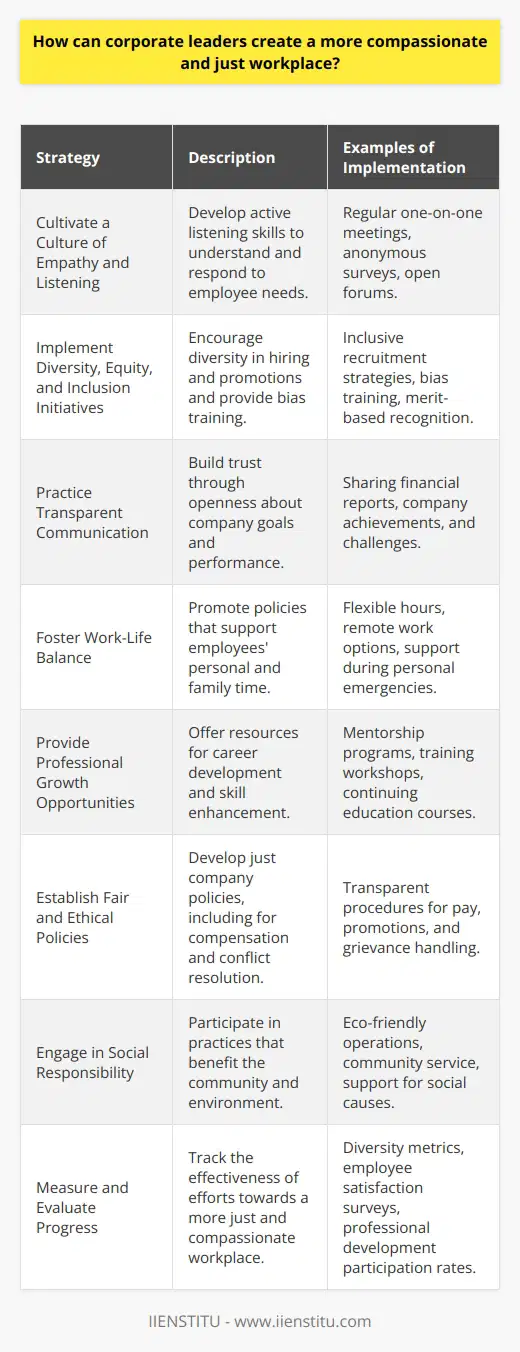
What are some examples of companies that have implemented compassionate HR policies?
Organizational compassion, or the practice of understanding in the workplace, has become increasingly popular in recent years. As a result, companies have begun to recognize the importance of creating a compassionate work environment to support their employees and increase their bottom line. This article will examine some examples of companies implementing human HR policies.
One example is Netflix, a streaming service company. Netflix has implemented several policies that demonstrate its commitment to a culture of compassion. For example, they have an open vacation policy, allowing employees to take as much time off as they need without fear of repercussions. Additionally, the company offers parental leave, adoption assistance, and fertility benefits, demonstrating its commitment to supporting employees in all aspects of their lives.
Another example is Microsoft, a technology company. Microsoft has implemented several policies demonstrating its commitment to creating a compassionate work environment. For example, they offer up to sixteen weeks of paid parental leave, allowing employees to work remotely. Additionally, they offer employees the opportunity to take sabbaticals, allowing them to take extended leaves of absence to focus on their personal growth and development.
Finally, Adobe, a software company, is another example of a company that has implemented compassionate HR policies. Adobe has implemented several approaches to create an inclusive and supportive work environment. For instance, they have an open vacation policy, allowing employees to take as much time off as they need without fear of repercussions. Additionally, they provide employees with mental health benefits, as well as support for parents, caregivers, and those with disabilities.
In conclusion, many companies have implemented compassionate HR policies to create a supportive and inclusive work environment. By providing employees with the opportunity to take time off, access mental health benefits, and work remotely, companies are demonstrating their commitment to organizational compassion.
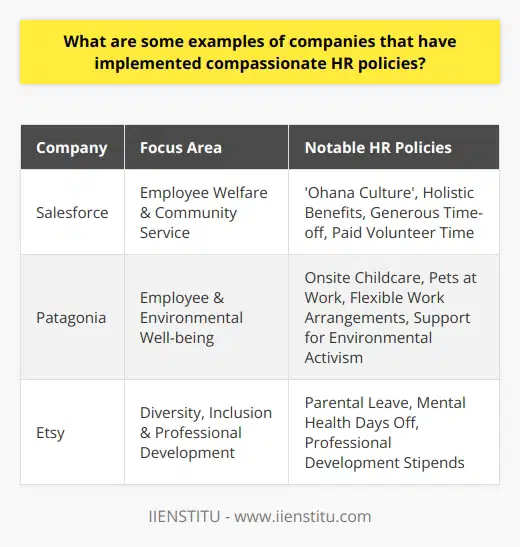
Why is equality, diversity, and inclusion essential for maintaining a thriving and resilient workforce?
The Importance of Equality, Diversity, and Inclusion
Equality, diversity, and inclusion (EDI) play a crucial role in fostering a thriving and resilient workforce. EDI policies and practices ensure that all employees feel valued and included, regardless of their gender, ethnicity, age, disability, or any other factor. Implementing these policies creates an environment where employees can bring their unique talents, skills, and perspectives to the table, increasing the overall effectiveness and adaptability of the organization.
Benefits of Harmonizing Differences
Embracing diversity in the workplace enables teams to leverage various perspectives and ideas, thereby promoting creativity and innovation. A diverse workforce exposes employees to differing viewpoints, experiences, and cultural backgrounds, creating opportunities for effective problem-solving and decision-making. This fosters a more productive and dynamic workplace, ultimately giving companies a competitive advantage.
Enhancing Employee Retention and Satisfaction
A commitment to EDI demonstrates to employees that the organization values their unique qualities and contributions. Research indicates that workplaces with robust EDI policies experience higher levels of employee satisfaction, engagement, and retention. Employees who feel valued and included are more likely to be loyal and committed to the organization, thereby reducing turnover and recruitment costs.
Reducing Discrimination and Bias
By promoting equality and inclusivity in the workplace, organizations can protect against discrimination and bias occurring, both of which have negative effects on workforce productivity and morale. Through training and awareness, employees can identify and address these issues, resulting in a healthier, more cohesive work environment where everyone feels supported and empowered.
Optimizing Talent Recruitment
Companies that prioritize EDI are able to attract top talent from a broader range of individuals. Recruiting from a diverse pool of candidates increases the likelihood of acquiring employees with unique skill sets, experiences, and perspectives that can enrich the organization. Moreover, demonstrating a commitment to EDI enhances the company's reputation, making it more appealing to prospective employees.
In conclusion, ensuring equality, diversity, and inclusion in the workplace is essential for maintaining a thriving and resilient workforce. By embracing individuals' unique qualities and harnessing their strengths, organizations can accelerate innovation, boost employee satisfaction, minimize discrimination and bias, and optimize talent recruitment. By doing so, companies create an environment where every employee can contribute to the organization's success while feeling valued and supported.
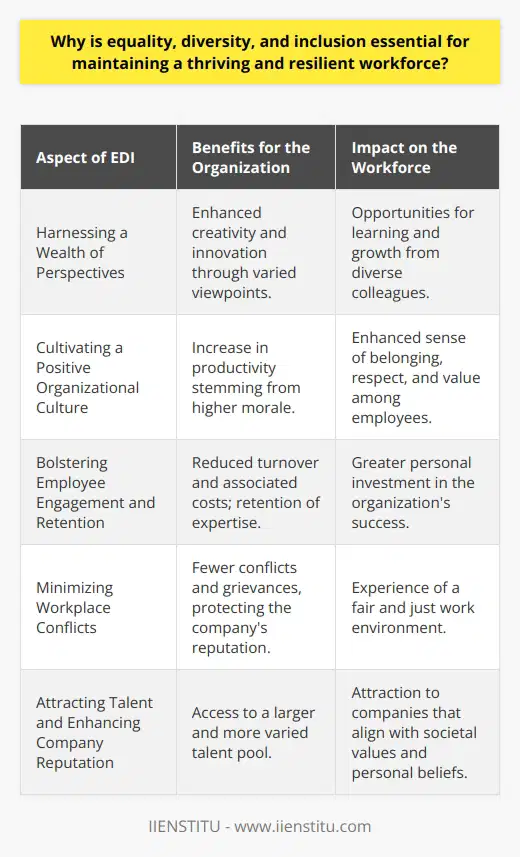
What strategies can HR practitioners implement to promote equality, diversity, and inclusivity within the organization?
Establishing a Comprehensive Policy Framework
To promote equality, diversity, and inclusivity within an organization, HR practitioners must first develop and implement comprehensive policy frameworks that encompass all aspects of employment, from recruitment to benefits administration. These frameworks should articulate a commitment to the principles of diversity, equality, and inclusion and provide clear guidance to employees and management regarding their responsibilities in promoting these fundamental values.
Expanding Recruitment Strategies
Next, HR professionals can broaden their recruitment strategies, drawing from diverse talent pools to enhance the range of perspectives within their employee base. This may include initiatives such as partnering with professional associations, universities, and community groups representing underrepresented groups, as well as utilizing inclusive job descriptions and advertising methods that appeal to candidates from diverse backgrounds.
Conducting Regular Training on Inclusivity
Additionally, conducting regular training sessions on inclusivity subjects, such as unconscious bias and cultural competence, will foster a more inclusive and supportive work environment. These trainings can help employees recognize and mitigate unintended discriminatory behaviors while promoting open-mindedness and respect for the unique qualities that each individual brings to the organization.
Facilitating Employee Resource Groups
Employee resource groups (ERGs) provide platforms for employees with shared characteristics or experiences, such as ethnicity, gender, or sexual orientation, to connect, collaborate, and address specific challenges they may face within the workplace. HR practitioners can support and facilitate the creation of these groups, empowering employees to take ownership of their diversity efforts and contribute to the organization's inclusivity objectives.
Implementing Recognition and Reward Systems
Integrating diversity and inclusion goals into recognition and reward systems, such as performance evaluations and bonus structures, can also serve as a powerful motivator for employees and management alike to embrace these values. By rewarding those who exemplify inclusive behaviors within the workplace, HR professionals can reinforce the organization's commitment to fostering an equitable and culturally diverse environment.
Monitoring and Reporting Progress
Finally, it is essential that HR professionals regularly monitor and report on progress towards achieving equality, diversity, and inclusivity goals. This includes tracking key performance indicators (KPIs) and conducting workforce analysis to identify any gaps or areas where targeted interventions may be required. By maintaining transparency and actively reporting on these efforts, HR practitioners can demonstrate ongoing progress and ensure that the organization remains steadfast in its commitment to fostering an inclusive, diverse, and equitable work environment.
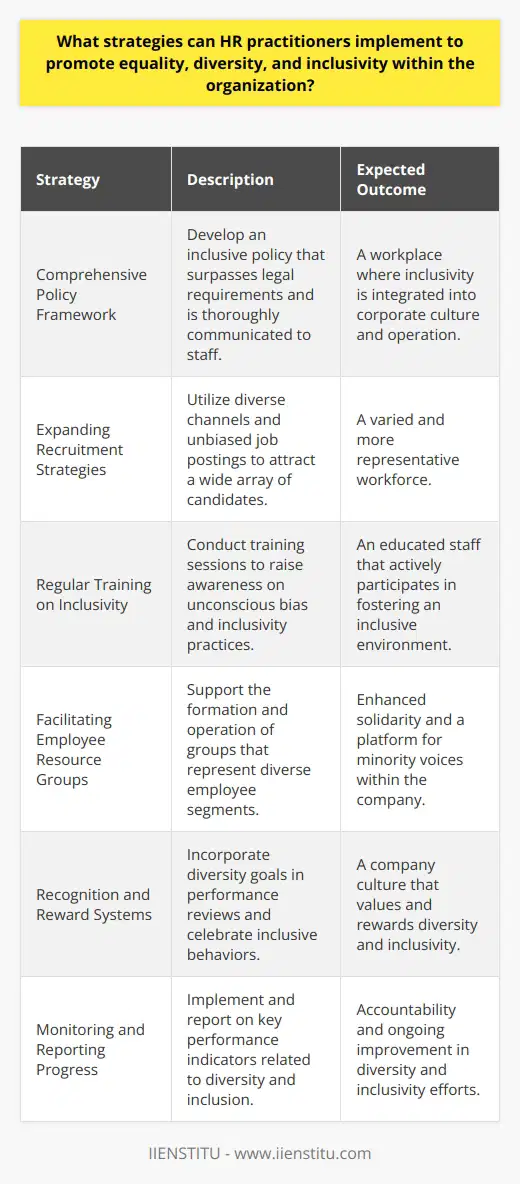
How can HR professionals address implicit bias and dismantle systemic barriers to foster a more equal and diverse workplace environment?
Identifying Implicit Bias
To address implicit bias, HR professionals must first recognize its existence within the workplace. This involves being aware of personal biases, stereotypes, and beliefs that might unconsciously impact decision-making and interactions with employees.
Implementing Bias Training
One effective strategy for combating implicit bias is to conduct comprehensive bias training programs. This will equip the HR professionals with the necessary tools to identify and mitigate implicit bias, ensuring that they make objective and fair decisions concerning recruitment, promotions, and performance evaluations.
Fostering Inclusive Leadership
Another approach to address implicit bias and actualize a more equal and diverse workplace is by promoting inclusive leadership. HR professionals can achieve this by recruiting, developing, and supporting leaders who prioritize diversity and inclusion within their teams, and by ensuring that policies and procedures align with these values.
Encouraging Employee Feedback
Seeking employee feedback can significantly contribute to addressing implicit bias, as it allows HR professionals to understand the specific concerns and experiences of the workforce. This feedback can influence the development of appropriate interventions and policies that actively dismantle systemic barriers.
Analyzing Data and Metrics
Regularly monitoring and analyzing data related to diversity and inclusion practices allows HR professionals to evaluate the efficacy of their initiatives. Assessing metrics such as attrition rates, promotion rates, and employee engagement can help identify areas of improvement and further develop strategies to foster a more equal and diverse workplace environment.
Reviewing Policies and Practices
To dismantle systemic barriers, HR professionals must review their organization's policies and practices regularly, ensuring they align with the goal of fostering diversity and inclusion. This may involve revising recruitment strategies, performance evaluation criteria, and promotions policies, among others, to guarantee equal opportunities for all employees.
Establishing Employee Resource Groups
Lastly, developing employee resource groups (ERGs) can provide employees with a platform to voice their opinions, share experiences, and collaborate on initiatives promoting diversity and inclusion. ERGs can also serve as liaisons between employees and HR professionals, helping to pinpoint systemic barriers and develop strategies to dismantle them.
In conclusion, addressing implicit bias and dismantling systemic barriers require the conscious and deliberate efforts of HR professionals in collaboration with employees. By implementing recommendations such as bias training, promoting inclusive leadership, analyzing data, and revising policies, HR professionals can greatly contribute to fostering a more equal and diverse workplace environment.

Why is equality diversity and inclusion important in HR?
Significance of Equality, Diversity, and Inclusion in HR
The Human Resources department is crucial to maintaining a harmonious workplace environment. Equality, diversity, and inclusion play pivotal roles in fostering a conducive and productive atmosphere by ensuring primary human values are respected and preserved. This article highlights the importance of these three elements in human resources management.
Enhances Organizational Performance
Equality, diversity, and inclusion contribute to improved organizational performance. Recognizing the value of a diverse workforce enables companies to capitalize on the varied skills, experiences, and perspectives that employees bring. A working environment that encourages collaboration among diverse groups increases innovation, creativity, and problem-solving abilities, leading to better decision-making and heightened performance.
Promotes Employee Engagement
Inclusion in the workplace means valuing and respecting all employees, regardless of their race, gender, age, sexual orientation, or disability. An inclusive work environment fosters employee engagement, leading to higher job satisfaction, improved morale, and increased likelihood of retaining top talent. Engaged employees tend to be more productive and committed, directly affecting the organization's bottom line.
Reduces Discrimination and Workplace Conflicts
Equality and diversity policies in HR help to reduce discrimination in the workplace. Such guidelines ensure that all employees have equal opportunities for growth, development, and progression, irrespective of their background. A harmonious work environment, where everyone is treated fairly, minimizes the risk of conflicts arising from discriminatory practices or unfair treatment.
Strengthens Legal Compliance
An organization that prioritizes equality, diversity, and inclusion in its HR policies is more likely to comply with legal requirements and avoid costly lawsuits. Discrimination and harassment claims can damage an organization's reputation, leading to a negative impact on customer perception and employee morale. By promoting and adhering to these principles, organizations protect themselves from potential lawsuits and loss of reputation.
Boosts Employer Branding
Emphasizing equality, diversity, and inclusion reflects positively on an organization's employer brand. A diverse and inclusive workplace appeals to potential employees and demonstrates a commitment to fairness, making the company a more attractive employer. Enhanced employer branding not only helps to attract top talent but also aids in building a positive public image.
In conclusion, incorporating equality, diversity, and inclusion in HR management is essential for organizations that seek to excel in their respective industries. It fosters a conducive work environment, promotes employee engagement, and ensures legal compliance while enhancing the overall reputation of the company. Organizations that value these principles will witness improved performance, reduced workplace conflicts, and a stronger employer brand.
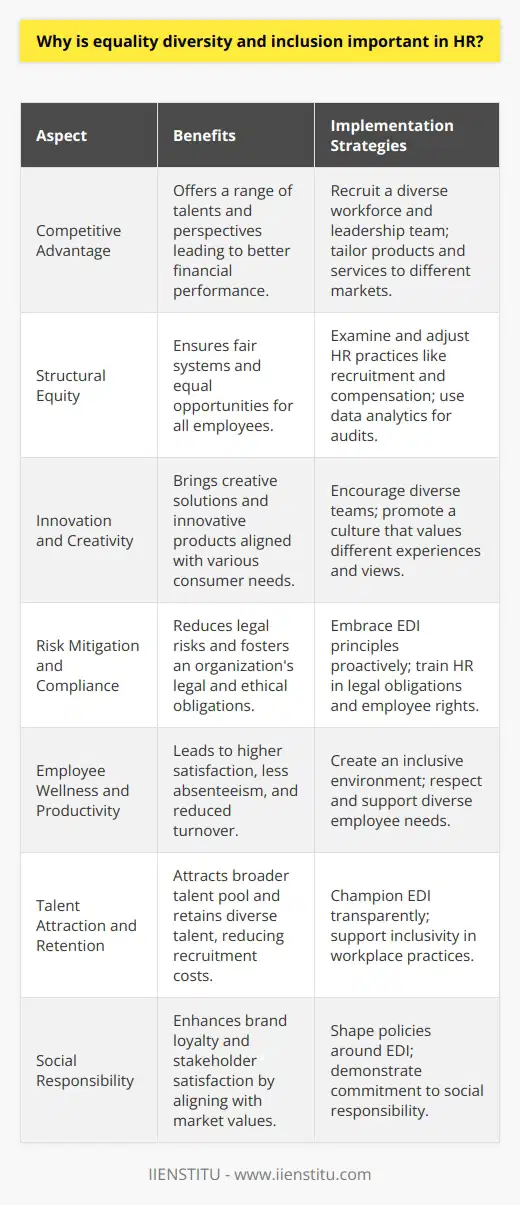
How does compassion promote equality?
The Role of Compassion in Fostering Equality
Understanding the concept of compassion
Compassion is the empathetic emotion towards the suffering of others, often accompanied by a desire to alleviate or reduce this suffering. It transcends superficial differences among individuals and promotes the recognition of shared humanity.
Compassion's impact on interpersonal relationships
By nurturing compassionate attitudes and behaviors, we encourage tolerance, acceptance, and the recognition of commonalities among diverse groups of people. Equality is promoted when we approach others with understanding, empathy, and kindness, regardless of their background or social status.
Influencing social interactions and systems
Compassion-driven actions and policies often address systemic inequalities and promote equal rights and opportunities for everyone. By centering compassion in decision-making processes, policymakers and leaders can create inclusive environments that counteract discrimination, prejudice, and exclusion, advancing equal treatment for all.
The effect on individual mindsets
When people cultivate compassion within themselves, it can lead to personal transformations that challenge biased beliefs and stereotypical assumptions. By fostering self-awareness and empathy, individuals can confront and dismantle ingrained prejudices, enabling more equitable perspectives and actions in their daily lives.
Encouraging collective change
Compassion also generates a ripple effect, inspiring collective change within communities and societies. As individuals and groups embrace and act upon compassionate values, they contribute to the creation of a more egalitarian world. This embodiment of compassion serves as a powerful catalyst for social progress toward a more just and equal society.
In conclusion, practicing and promoting compassion plays a significant role in fostering equality by bridging divides between people, transforming individual mindsets, influencing social systems, and inspiring collective change. By cultivating a compassionate and empathetic approach to others, we contribute to the creation of a more equitable and just world for everyone.

What are your responsibilities for equality and diversity in the workplace?
Understanding Equality and Diversity
In order to uphold responsibilities towards equality and diversity in the workplace, it is essential to first understand the concept. Equality refers to a situation where all employees have equal access to opportunities, resources, and benefits, irrespective of their individual differences. Diversity, on the other hand, is about recognizing and valuing these differences among employees.
Being Inclusive in Practice
Practicing inclusiveness requires creating an environment that is free from discrimination, where each person feels welcomed, respected, and valued. In order to maintain an inclusive workplace culture, it is crucial to incorporate the principles of equality and diversity into everyday practices.
Demonstrating Respect and Fairness
As an employee, promoting respect and fairness is an important aspect of ensuring equality and diversity in the workplace. By treating all colleagues with the same level of respect, irrespective of their cultural background, gender, or abilities, one can help foster a cohesive and positive working environment.
Promoting Open Communication
Open communication is a key factor in achieving a diverse and equitable workplace. Encouraging transparent dialogue can help address any misunderstandings, misconceptions, or biases. By providing a safe space for sharing personal experiences and opinions, employees can build trust and empathy for one another.
Challenging Discrimination and Bias
An employee's responsibility for equality and diversity extends to challenging discrimination and bias when they arise. Being aware of one's own biases and prejudices is essential, as well as actively addressing any instances of discrimination, both overt and subtle, in the workplace.
Participating in Training and Development
Lastly, participating in professional development opportunities related to equality and diversity is crucial for personal growth and awareness. Engaging in training sessions, workshops, or seminars can equip employees with the necessary knowledge and skills to support diversity and inclusion in their daily work experiences.
In conclusion, being responsible for equality and diversity in the workplace involves understanding and valuing differences, practicing inclusiveness, demonstrating respect and fairness, promoting open communication, challenging discrimination and biases, and investing in personal development. By embracing these principles, employees can contribute to creating a more equal, inclusive, and thriving work environment.
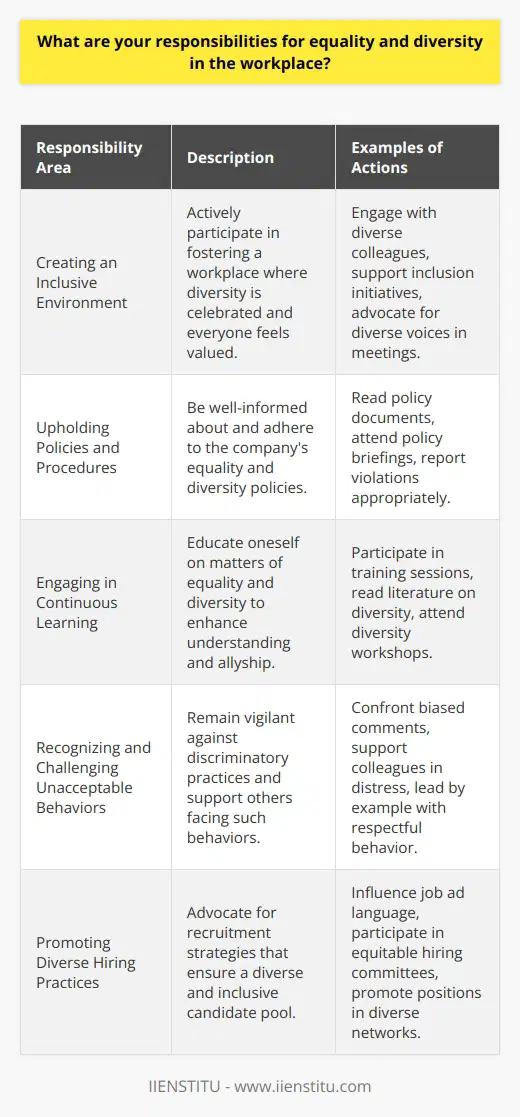
How can HR support diversity and inclusion initiatives to create a more equitable workplace?
Implementing Diversity Initiatives
HR can support diversity initiatives by developing inclusive hiring strategies. This might include targeting job advertisements towards diverse audiences or ensuring that job requirements do not disadvantage certain groups.
Enforcing Equitable Policies
Inclusive onboarding and training initiatives is another avenue for HR. All employees should understand the company's commitment to diversity and have the skills to interact respectfully with a diverse range of clients and colleagues.
Supporting Inclusive Culture
Culture plays a significant role in creating an inclusive workplace. HR can encourage inclusivity by celebrating cultural and diversity events, promoting diverse voices within the company, and soliciting and actioning feedback from staff on issues of diversity and inclusivity.
Promoting Employee Engagement
Inclusion is not just about diversity, but about how well different groups feel they belong, are valued and can participate in the organization's life. HR can promote engagement by setting up mentorship and leadership development initiatives specifically for underrepresented groups.
Adhering to Legislation
Ensuring legislative compliance is another avenue for HR to support diversity and inclusion. They can help their organization meet their legal obligations, in terms of employment equity, by staying current with changing laws and regulations, and implementing necessary changes within the workplace.
In conclusion, HR can support diversity and inclusion initiatives in the workplace by implementing inclusive hiring practices, training staff on diversity issues, promoting a culture of inclusion, encouraging employee engagement, and ensuring legislative compliance.

In what ways can organizations promote compassionate leadership to foster inclusivity and empathy among their employees?
Promotion of Training Programs
Organizations can promote compassionate leadership by implementing ongoing training programs. These programs should emphasize unique strategies to demonstrate empathy, promote inclusivity and address unconscious bias. Regularly scheduled workshops can be an effective tool, providing a safe space for self-reflection and personal development.
Developing Leadership Traits
At the core of compassionate leadership lies emotional intelligence; the ability to identify, understand and manage emotions. Organizations must encourage managers to develop their emotional intelligence, fostering greater empathy towards employees. This trait enables leaders to understand the emotional needs of their team members better.
Strategic Communication
Effective communication is paramount in promoting compassionate leadership. Organizations need to model open conversation that acknowledges the feelings of others. Respectful exchanges encourage trust and mutual respect, leading to an inclusive work culture.
Incorporating Compassionate Policies
Incorporating policies that prioritize wellbeing shows compassion. Employers could provide flexible work schedules or mental health days, acknowledging that employees have personal lives too. Such policies not only promote inclusivity but also show understanding of diverse needs.
Rewarding Compassionate Acts
Acknowledging and rewarding acts of compassion in the workplace can also encourage compassionate leadership. Recognition of compassionate acts reinforces the significance of empathy in workplace culture while incentivizing similar behavior among employees.
In conclusion, promoting compassionate leadership involves a multi-faceted approach. Organizations must initiate training programs, develop emotional intelligence, communicate effectively, implement compassionate policies, and reward acts of compassion. By doing so, they can foster a more inclusive and empathetic workplace culture.
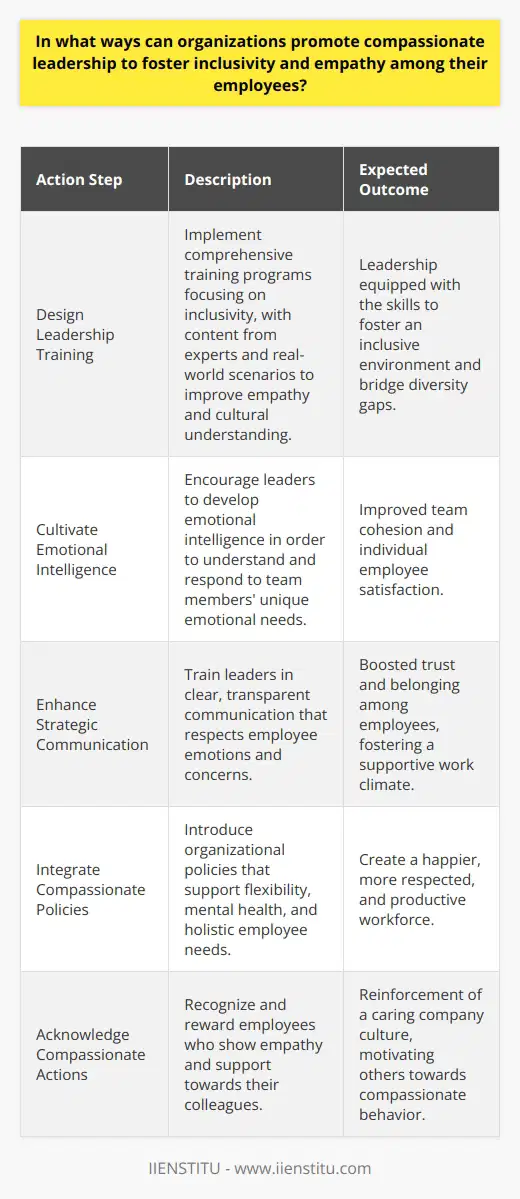
Why is it essential for HR managers to prioritize equality, diversity, and inclusion in the recruitment, retention, and development of talent within an organization?
Prioritizing Equality
It is important that HR managers prioritize equality to ensure equal opportunities for all potential and existing employees. By adopting fair recruitment, retention and development processes, they eliminate biases which leads to a more diverse workforce. A balanced workforce reduces feelings of favoritism and enhances employee satisfaction levels.
Diversity in Talent Acquisition
Adopting diversity in talent acquisition is essential to bring together a mix of different skills, ideas and perspectives within the organization. It results in a broader range of innovative ideas and approaches to problem-solving. A diverse talent pool also offers a competitive edge to the organization in an often variant market scenario.
Inclusion for Employee Retention
Inclusion ensures that all employees feel valued and essential to the organization. It aids in retaining top talent, improving productivity and maintaining a harmonious work environment. Inclusive practices foster a sense of belonging and motivate employees to contribute their best.
Making Equality, Diversity, and Inclusion a Priority
In sum, HR managers must prioritize equality, diversity, and inclusion in talent recruitment, retention, and development. Not only does it help in building a more productive and innovative workforce, but it also promotes a healthy, inclusive and unbiased work environment. By doing so, organizations can harness the full potential of their human resources, leading to better growth and success.
